 klaus-michael schneider
klaus-michael schneider
Keywords: education |
Links: FOTW homepage | search | disclaimer and copyright | write us | mirrors

Last modified: 2021-05-22 by  klaus-michael schneider
klaus-michael schneider
Keywords: education |
Links: FOTW homepage |
search |
disclaimer and copyright |
write us |
mirrors
![[Flag of Colombia]](../images/c/co.gif) (2:3)
(2:3)  image by Željko Heimer, 20 May 2001
image by Željko Heimer, 20 May 2001
See Also:
 image resized from municpal website
image resized from municpal website
"Instituto Agrěcola de Carcasí" (ITA) was founded
on 16 April 1953 (Decree No. 0991) as "Escuela Vocacional
Agrícola" at Carcasí,
Department of Santander.
The flag of the institute, as shown graphically and described on
the institute's
website, is divided green-white by the descending diagonal
with a yellow wheat stem in the middle.
Green symbolizes the fields while white symbolizes purity and the
aspiration to peace.
The wheat stem represents the soil fertility and the strength and
progress of the local people.
Oddly enough, the very same flag is presented as the municipal
flag, with the very same description, on the municpal
website.
Ivan Sache, 14 April 2009
See also: Carcasi (Santander, Colombia).
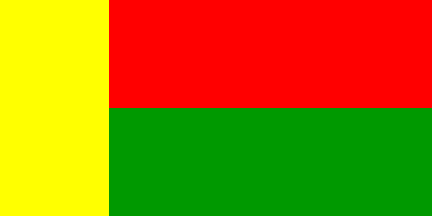 image by Ivan Sache, 02 December 2014
image by Ivan Sache, 02 December 2014
Institución Educativa Cardenal Aníbal Muñoz Duque was established in
Santa Rosa de Osos (Antioquia Department) by Departmental Resolution
No. 1,469 of 20 February 2003 as the merger of Colegio Cardenal Aníbal
Muñoz Duque, Escuela María Auxiliadora (est. 1914), Escuela Urbana
Integrada Arenales (est. by Ordinance No. 33 of 30 December 1968) and
Instituto Nuestra Señora del Carmen (est. 1920). Another three schools
originally part of the merger were separated by Departmental
Resolution No. 32,578 of 21 December 2009 to form
Institución
Educativa Marco Tobón Mejía.
Instituto Departamental de Enseñanza Media was established by
Departmental Decree No. 113 of 11 February 1970 and renamed Instituto
Departamental de Enseñanza Media Cardenal Aníbal Muñoz Duque by
Departmental Decree No. 1,285 of 10 May 1991, Liceo Cardenal Aníbal
Muñoz Duque by Departmental Decree No. 2,637 of 8 July 1996, and,
eventually, Colegio Cardenal Aníbal Muñoz Duque by Departmental Decree
No. 9,167 of 17 November 2000.
The institute is named for Aníbal Muñoz Duque (1908-1987), born in
Santa Rosa de Osos. elevated to Cardinal (Cardinal-Priest of San
Bartolomeo all’Isola) on 5 March 1973 by Pope Paul VI. He was also
Bishop of Socorro y San Gil (1951) and of Bucaramanga (1952),
Archbishop of Nueva Pamplona (1959) and Bogotá (1972-1984), and
Military Bishop of Colombia (1972-1984).
The flag of the institute, prescribed by Resolution No. 2, adopted in
October 1967, is horizontally divided red-green, with a vertical
yellow stripe placed along the hoist.
The yellow stripe represents the light that enlightens the academic
and pedagogic advance of the institute.
The red stripe represents force and struggle for personal and
collective surpassing.
The green stripe represents the aspiration of the children and
teenagers to build up newer and better generations.
Source:
http://www.iecamd.edu.co/nuestra-inst/simbolos-institucionales.html
- institute's website
Ivan Sache, 02 December 2014
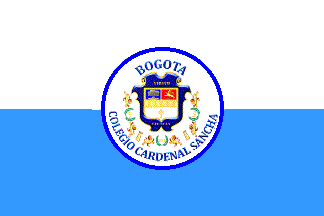 image by Ivan Sache, 20 July 2014
image by Ivan Sache, 20 July 2014
Colegio Cardenal Sancha was established on 10 February 1961 in Teusaquillo
borough (Bogotá) by Helena Cruz and Germania Hernández, two Sisters of the
Charity, a congregation founded in 1869 in Spain by Cardinal Sancha. The
institute was relocated on 30 January 1967 to El Calleja borough. Ciriaco María
Sancha y Hervás (1833-1909; beatified on 18 October 2009) was Bishop of Ávila
(1882), Bishop of Madrid-Alcalá de Henares (1886), and Archbishop of Valencia
(1892). He was appointed Cardinal on 18 May 1894 by Pope Leo XIII.
The
flag of the institute is horizontally divided white-Marian blue with the
institute's emblem in the middle.
The emblem of the institute features:
- a lion, emblem of the Sancha family and a symbol of virtue and maturity;
-
a tree, emblem of the Hervás family and a symbol of growth;
- a cross, emblem
of redemption and a symbol of love, sacrifice and charity;
- a collar, emblem
of the awards granted to Cardinal Sancha.
http://www.colegiocardenalsancha.edu.co/simbolos.html - Institute's website
Ivan Sache, 20 July 2014
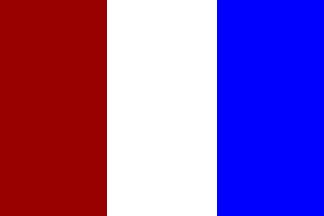 image by Ivan Sache, 9 January 2009
image by Ivan Sache, 9 January 2009
"Colegio de la Libertad" was founded on 5 February
1868 in the presbytery of Palmira (Department of Valle), with
classes in French, Spanish, Arithmetics, Economics and Geography.
The institute was subsequently relocated into a former colonial
tobacco warehouse; in 1929, it was renamed "Colegio de
Cárdenas", as a tribute to the local politician Vincent de
Cárdenas (1811-1880), Senator and Governor of different
departments.
In September 2002 (Decree No. 1784), the Department of Valle
split "Colegio de Cárdenas"; the former
secondary seat of the institute located in the borough of
Mirriñao became "Institución Educativa Cárdenas de
Mirriñao", incorporating the "Benilda
Caicedo", "Ricardo Nieto", "Gran
Colombia" institutes and "Centro de Educación Especial
Carlos Arturo Rodríguez".
The flag of the institute, as shown graphically and described on
the webpage
of the institute, is vertically divided crimson-white-blue,
representing the religious values, purity, and the seas and
heavens, respectively.
Ivan Sache, 9 January 2009
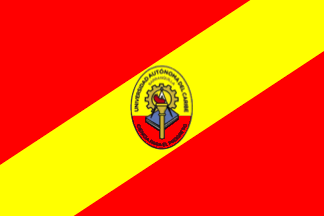 image by Ivan Sache and
Tomislav Todorovic, 10 January 2020
image by Ivan Sache and
Tomislav Todorovic, 10 January 2020
Universidad Autónoma del Caribe (UAC) was established on 27 March 1967 in
Baranquilla and officially incorporated by Resolution No. 303 issued on 3 April
1967. Classes started on 24 July 1967 in the Faculties of Administration of
Public and Private Business, Industrial Relations, and Accounting and Finance
Sciences.
The status of university was fully granted by Ministerial Decree
No. 2,694 issued on 12 December 1974.
UAC is composed of the Faculties of
Architecture and Design; Social and Human Sciences; Administration, Economy and
Accounting Sciences; Engineering; and Jurisprudence.
https://www.uac.edu.co
UAC website
The flag of UAC is shown in the
university's Statutes, approved by Agreement No. 131-01 issued on 5 December
2003.
https://studylib.es/doc/4653748/estatuto-general---universidad-autónoma-del-caribe
UAC Statutes
The flag is red with a yellow stripe running from the lower
fly to the upper joist, charged in the center with the university's emblem.
Photos
https://zonacero.com/videos/calle-de-honor-una-bandera-de-colombia-canticos-y-lagrimas-para-estudiantes-de-sede-de-la
https://politika.com.co/mauricio-molinares-canavera-rector-de-la-universidad-autonoma-del-caribe-recibira-el-premio-politika-2020-gestion-y-liderazgo
https://www.uac.edu.co/oferta-academica/inicio/item/4560-generar-conciencia-y-valores-medioambientales-la-apuesta-de-los-proyectos-presentados-en-la-tercera-version-de-green-academy
https://decaraconelatlantico.blogspot.com/2020/01/la-fundacion-telefonica-moviatar-y-la.html
The coat of arms of UAC, designed by founding rector Mario Ceballos
Araújo, features a book representing knowledge, a pair of compasses representing
art, and a cogwheel representing economy. It is inscribed with the motto "Ciencia
para el progresso" (Science for Progress).
https://www.uac.edu.co/la-universidad/acerca-de/emblemas
UAC website
Ivan Sache, 10 January 2020
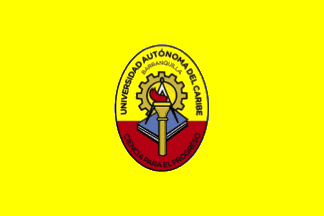 image by Ivan Sache, 10 January 2020
image by Ivan Sache, 10 January 2020
Photos
https://www.wradio.com.co/noticias/actualidad/ramses-vargas-renuncio-como-rector-de-la-universidad-autonoma-del-caribe/20180301/nota/3718145.aspx
https://hablabarranquilla.com/2020/12/11/alcaldia-de-malambo-amplia-convenio-con-universidades-para-gratuidad-en-educacion-superior
https://elperiodicodeportivo.com.co/noticias/deportes/lorenzo-orellano-el-manco-del-futbol-colombiano-fue-becado-136086
Ivan Sache, 10 January 2020
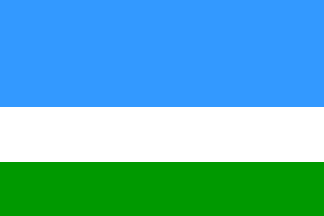 image by Ivan Sache, 17 November 2014
image by Ivan Sache, 17 November 2014
Institución Educativa Técnica Carlos Alberto Olano Valderrama is located in
Belén (Boyacá Department). The institute is named for the lawyer Dr. Carlos
Alberto Olano Valderrama (d. 1993), Professor of Constitutional Law at
Universidad La Gran Colombia (1970-1795), of Transportation Law at Universidad
Santo Tomás (1976) and of Constitutional Law at Universidad Militar Nueva
Granada (1976-1984). He was Senator (1961-1966) and Minister of Work and Public
Safety (1965-1966). In Belén, he managed a cheese factory with his uncle Marco
Aurelio (full
biography).
The flag of the institute is horizontally divided blue-white-green (2:1:1).
Source:
http://iecaovbelen.jimdo.com/s%C3%ADmbolos-institucionales/ - Institute's
website
Ivan Sache, 17 November 2014
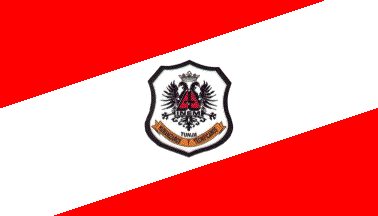 image by Ivan Sache, 26 September 2014
image by Ivan Sache, 26 September 2014
INEM Carlos Arturo Torres was established in Tunja (Boyacá Department) by
Decree No. 1,962 of 20 November 1969. Classes started on 1 April 1972.
The institute is named for the writer, journalist and politician Carlos Arturo
Torres Peña (1867-1911). He published in 1909 his three most significant works,
"Obra Poética", "Estudios Ingleses", and "Idola Fori". A moderate member of the
Liberal Party, he served as Ministry of the Treasure (1903) and Ministry of the
Interior (1904).
The symbols of the institute was designed by the teachers Ernesto Hernández
Zambrano (Department of Industrial Education) and Blanca Mancipe de Hernández (Department
of Humanities and Spanish language). The flag is red with a broad white diagonal
stripe charged with the institute's emblem. The emblem features a double-headed
eagle, the heraldic emblem of the town of Tunja.
Source:
http://inemtunja.edu.co/institucional_simbolos.php - Institute's website
Ivan Sache, 26 September 2014
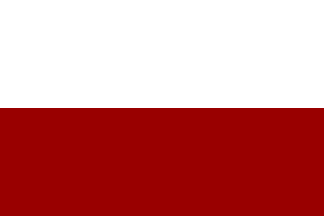 image by Ivan Sache, 8 January 2009
image by Ivan Sache, 8 January 2009
"Instituto Tecnológico Carlos Hernández Yaruro"
located in the village of La Ermita, Municipality of Ocaña,
Department of Norte del Santander, was recognized by the
Department of Norte del Santander on 19 May 1997 (Decree No.
016), as the successor of an institute founded in 1945 by the
late Dr. Carlos Hernández Yaruro for the education of farmers'
children.
The flag of the institute, as shown graphically and described on
the website
of the institute, is horizontally divided white-dark red
("vino tinto", lit., "red wine").
White means purity and loyalty, commitment to conquest and
preservation of peace.
Dark red means the products of effort.
Ivan Sache, 8 January 2009
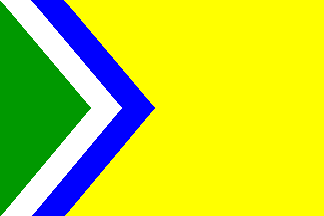 image by Ivan Sache, 14 November 2010
image by Ivan Sache, 14 November 2010
Colegio Carlos Julio Torrado Peñaranda (COLCAJUTO), located in Abrego
(Department of Norte de Santander), was founded on 6 July 1988 by Carlos Julio
Torrado Peñaranda; on 30 September 2002, Departmental Decree No. 764 created
Institución Educativa Carlos Julio Torrado Peñaranda by the merging of Colegio
Carlos Julio Torrado Peñaranda, Escuela Simón Bolívar and Escuela La Piñuela.
The flag of COLCAJUTO, as shown graphically on the institute's website, is
yellow with a green triangle placed along the hoist and separated from the
yellow field by two chevrons, white and blue, respectively. Green represents the
aspiration to an educational project and the green pastures. White represents
peace and tolerance encompassed in the educational project. Blue represents the
sky and the crystalline local waters. Yellow represents light and wealth.
Source:
http://colcajuto.edu.co/index.php?option=com_content&view=article&id=57&Itemid=64
Ivan Sache, 14 November 2010
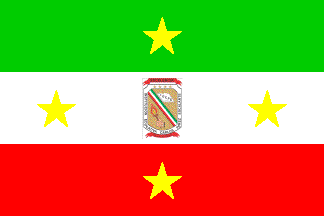 image by Ivan Sache, 26 September 2014
image by Ivan Sache, 26 September 2014
Institución Educativa Carlos Pérez Escalante was established in 2002 in
Cúcuta (Norte de Santander Department) as the merger of Colegio Departamental
Carlos Pérez Escalante (est. by Ordinance No. 15 of 30 November 1978), Colegio
Departamental Integrado San Luis (est. by Ordinance No. 21 of 7 December 1987),
Escuela Marco Fidel Suárez (est. in 1900, as Escuela Pública de Varones),
Escuela Santa Isabel de Hungria (est. by Decree No. 618 of 7 February 1988), and
Escuela Nuestra Señora de Chiquinquira (est. 21 February 1973). The institute is
named for Carlos Pérez Escalante, Governor of the Norte de Santander Department
(1971-1973).
The flag of the institute, designed by Cristóbal Molina García, is horizontally
divided green-white-red with the institute's emblem in the middle, a yellow star
in the middle of the green stripe, a yellow star in the middle of the red star,
and two yellow stars surrounding the emblem in the white stripe. Green is a
symbol of hope, prosperity, and natural environment. White is a symbol of purity
and honesty. Red is a symbol of force, energy, blood, and power. The stars
represent the four schools merged to form the institute.
Source:
http://iecarpes.edu.co/portal/nuestro-colegio/simbolos/ - Institute's
website
The emblem of the institute, designed by Ramiro Rozo Gómez, is diagonally
divided by a green-white-red stripe, representing the institute's flag. The
golden background represents our resources. The upper part of the emblem
features a book inscribed with the letters "IECPE", the institute's initials.
The book is a symbol of knowledge. The lower part of the emblem features a
burning torch, representing the master who shows the light and the way to
knowledge.
The shield has a white border inscribed with the name of the institute and
charged in the upper part with four yellow stars, as on the flag. The shield is
surmounted by a red scroll inscribed with "EXCELENCIA" (Excellence) in black
letters, symbolizing the mission, vision, and philosophy of the institute.
Beneath the shield, another red scroll is inscribed with the institute's motto,
"Ciencia y Virtud" (Science and Virtue).
Source:
http://iecarpes.edu.co/portal/nuestro-colegio/simbolos/ - Institute's
website
Ivan Sache, 26 September 2014
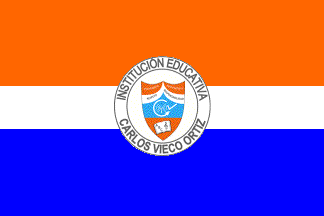 image by Ivan Sache, 12 October 2018
image by Ivan Sache, 12 October 2018
IED Colegio Carlos Pizarro Leongómez is located in Bosa (Bogotá). The school
is named for Carlos Pizarro Leongómez (1951-1990). Expelled from Universidad
Javeriana after having organized a strike, Pizarro joined the Fuerzas Armadas
Revolucionarias de Colombia (FARC) in 1968. A founding member in 1971 of
Movimiento 19 de Abril (M-19), he was involved in most guerilla actions
organized by the movement. Jailed from 1979 to 1983, Pizarro resumed armed
struggle until the cease-of-fire signed on 24 August 1984. The truce was broken
after the attempt against the M-19 spokesperson, Antonio Navarro Wolff (b.
1948); Pizarro organized Batallón América, active in Cauca Department. On 5
November 1985, M-19 assaulted the Palace of Justice in Bogotá. Ten days later,
the building was seized by the army; ten magistrates of the Supreme Court and
more than 100 guerilleros and soldiers were killed during the event. On 13 March
1986, Pizarro succeeded Alvaro Fayad (1946-1986) as the leader of M-19. On 25
January 1990, M-19 abandoned armed struggle and morphed into a political party,
Alianza Democrática M-19. Pizarro announced on 9 March 1990 he would be
candidate to the municipal election in Bogotá, and, 15 days later, to the
presidential election. Pizarro promoted a nationalist, Bolivarian program based
on social equity, tolerance and respect of ideological pluralism. Murdered on 26
April in a plane flying to Baranquilla, Pizarro was succeeded by Antonio Navarro
Wolff, who would be the first ex-guerillero to be appointed Minister (Minister
of Health; 1990-1991).
https://sites.google.com/site/colpizarro/natalia-mallama
School website
The flag of IED Colegio Carlos Pizarro Leongómez, designed by Angie Coca,
contains ascending curve lines, which represent the different stages of life.
The yellow disk represents light as a guide and a source of joy and love for the
school. Blue represents the sky and water, expressing confidence, friendship and
liberty, which are fundamental values to be taught and increased at the school.
White represents peace, childhood, innocence, calm, harmony and the purity of
our actions. Green represents hope and aspiration to be better every new day.
https://sites.google.com/site/colpizarro/simbolos-institucionales
School
website
Ivan Sache, 12 October 2018
 image by Ivan Sache, 22 September 2014
image by Ivan Sache, 22 September 2014
Institución Educativa Carlos Vieco Ortiz was established in San Javier (Antioquia
Department) by Resolution No. 16,432 of 20 December 2010, as the separation of
three components from Institución Educativa Benedikta Zur Nieden: Escuela Vieco
Ortiz, Escuela Municipal San Javier, and Escuela Juan de Dios Aránzazu. The
institute is named for the musician and composer Carlos Vicente Ortiz
(1905-1975), of national and international fame, author of more than 3,000 works.
Source:
http://www.carlosvieco.edu.co - Institute's website
The flag is horizontally divided orange-white-blue (2:1:2), with the institute's
emblem in the middle. Orange, taken from the flag of Escuela Vieco Ortiz, is a
symbol of force and enthusiasm for integral education of respectful and
responsible men and women. White, taken from the flag of Escuela Municipal San
Javier, is a symbol of peace, purity, and open expression of the students,
commitment to truth, and belonging to the institute. Blue, taken from the flag
of Escuela Juan de Dios Aránzazu, is a symbol of serenity, faith, creativity,
harmony, and tolerance.
The emblem of the institute is made of a Swiss-shaped shield placed on a white
background and surrounded by a ring inscribed with the name of the institute in
black letters. The shield is horizontally divided in three horizontal stripes.
The upper, orange and white stripe, is structured like a curtain, as a symbol of
the opening of the institute to change, and inscribed with the institute's
values, "TOLERANCIA" (Tolerance), "PERTINENCIA" (Belonging), "RESPETO" (Respect),
and "RESPONSABILIDAD" (Responsibility). The median, blue stripe, is charged with
the symbol of perpetual improvement, based on the cycle "To plan, to act, to
check, to adjust". Inside the cycle is an antenna symbolizing the used of
technological means of information for the improvement of basic skills, and, on
its side, the checking symbol that allows the identification of improvement
actions. The lower, orange stripe is charged with an open book, whose left page
is inscribed with the letters "ABC".
Source:
http://www.carlosvieco.edu.co/gestion-directiva/simbolos - Institute's
website
Photos:
https://picasaweb.google.com/116080435008534669377/EvidenciasDeProyectosObligatorios2014#6036998381126228546
https://picasaweb.google.com/116080435008534669377/EventosYActosCivicos2012#5740331968624897026
https://picasaweb.google.com/116080435008534669377/LanzamientoDeSimbolos#5674302809888365810
https://picasaweb.google.com/116080435008534669377/DiaDelProfesorCarlosVieco2014#6037013079671871586
https://picasaweb.google.com/116080435008534669377/DiaDelMaestro#5747917525321582722
https://picasaweb.google.com/116080435008534669377/PosesionGobiernoEscolar2013#5858717470073979410
Ivan Sache, 22 September 2014
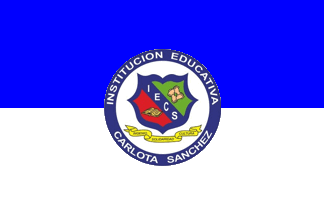 image by Ivan Sache, 13 May 2021
image by Ivan Sache, 13 May 2021
Institución Educativa Carlota Sánchez is located in Pereira (Risaralda).
The flag of IE Carlota Sánchez is horizontally divided blue-white with
the school's coats of arms in the center.
Blue represents justice, zeal, truth, loyalty and beauty.
White is associated with light, faith and purity.
The coat of arms is composed of a blue shield crossed by a diagonal
stripe inscribed with the white initials "IECS". The green part is
charged with a handshake composed of four right hands, meaning union,
solidarity and common action in the school. The red field symbolizes
friendship, generosity, triumph and audacity, charged with an open book
symbolizing intellectual resources, consecration and transcendence,
faith in progress and prosperity. Yellow is a symbol of power, light and
wisdom.
Source: manual de convivencia
Ivan Sache, 13 May 2021